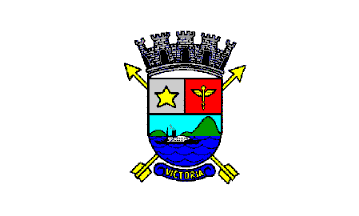 image by Carlos Noronha
image by Carlos Noronha
Last modified: 2012-02-11 by ian macdonald
Keywords: espirito santo | vitória |
Links: FOTW homepage |
search |
disclaimer and copyright |
write us |
mirrors
Information on the flag of Vitória is at the
city's official website.
Dov Gutterman, 28 January 1999
The flag is very simple: white with the coat of arms in the center.
Carlos Noronha, 7 February 1999
The municipality of Vitória (330,526 inhabitants in 2011; 93 sq. km) is
the capital of Espírito Santo. The municipal territory is made of Ilha de
Vitória, an archipelago of 33 islands, linked to the mainland by seven
bridges, and of a small part of mainland.
Vitória is the second oldest
State capital in Brazil. In 1534, 34 years after the official discovery of
Brazil, King of Portugal John III divided the country into hereditary domains
("capitanias"). Vascos Fernandes Countiho was granted Espírito Santo; he
founded Vila Velha ("Old Village") on 23 May 1535. Located on the mainland at
the foot of the Penha hill, the settlement was prone to native, Dutch and
French raids. In search of a safer place, the Portuguese colonists moved the
capital to an island located in the bay, which they called Santo Antônio. The urbanists of the time designed a town with houses interspersed with maize
plots, known to the natives as "capixabas". Originally the nickname of the
inhabitants of Vitória only, "capixabas" is used today to design the
inhabitants of the whole Espírito Santo State. On 8 September 1551, the
Portuguese defeated the Goytacazes natives. The victory prompted to change
the name of the island and town to Vitória, subsequently modernized to
Vitória. On 24 February 1823, the municipal statute was granted to Vitória by
an Imperial Decree-Law. Vitória is known as "Cidade Sol" (Sun City), as a
reference to the song "Vitória Cidade Sol" written by the musician Pedro
Caetano (1911-1992) and officially adopted by the Municipal Council as the
Municipal Emotional Anthem. The song starts with "Cidade Sol, com o céu
sempre azul" (Sun City, with the sky always blue).
The symbols of
Vitória are prescribed by Municipal Law No. 2,555 of 26 May 1978. The
flag is white with the coat of arms in the middle (Article 5). The dimensions
of the flag are 14 units in height on 20 units in width, those of the coat of
arms are 7 units on 6 units (Article 6).
The "reestablished" coat of arms
is "a rounded-off or Iberic shield; in canton, a five-pointed star or on a
field argent; in the opposed quarter a caduceus (symbol of trade) or on a
field gules; in the lower quarter, a panoramic picture proper of the entrance
of the town: in the background, vert, the Penhedo and Ilhas das Pombas
(Doves' Island), in the foreground, on a sea azure a steamboat. The shield
ensigned with a mural crown argent, made of eight towers ports sable. The
shield supported by two arrows or crossed per saltire. A scroll azure with
the writing "Victória " in letters or." (Article 2)
The shield, in the
shape once used in Portugal is a tribute to the first colonists of our
country. The star represents the Epsilon star portrayed on the national flag,
as a tribute to the Espírito Santo State. Argent represents purity. Or
represents wealth. The caduceus represents trade, the main source of income
of the municipality. Gules (red) represents justice. The Pehedo and
Ilhas das Pombas are rocky geographical accidents. The steamboat "dates back"
to 1913. Vert (green) represents fertility. Azure (blue) represents
nobleness and serenity. The mural crown is a symbol of political
emancipation. Its open gates symbolize the hospitality of the inhabitants.
The arrows symbolize our origins. The scroll, inscribed with "Victória" (the
written form of the time) recalls the victory of the colonists on the
confederated native tribes. (Article 3)
http://sistemas.vitoria.es.gov.br/webleis/Arquivos/1978/L2555.PDF - Full
text of the Law
The Law prescribes the writing "Victória", which is
conformed by the PDF file showing the flag on the municipal website. However,
the flag in use, as shown on a photo available in the very same website, is
inscribed "Vitória", as is the black and white coat of arms represented on
the header of the Law!
http://www.vitoria.es.gov.br/arquivos/20091006_bandeira_de_vitoria.pdf - Drawing of the flag, municipal website
http://www.vitoria.es.gov.br/semc.php?pagina=simbolosmunicipais - Photo of
the flag, municipal website
The image shown above, although globally
correct, is worth redrawing. The first quarter should be white instead of
silver, and there are some adjustments required in the size and placement of the
element of the coat of arms.
Ivan Sache, 23 January 2012